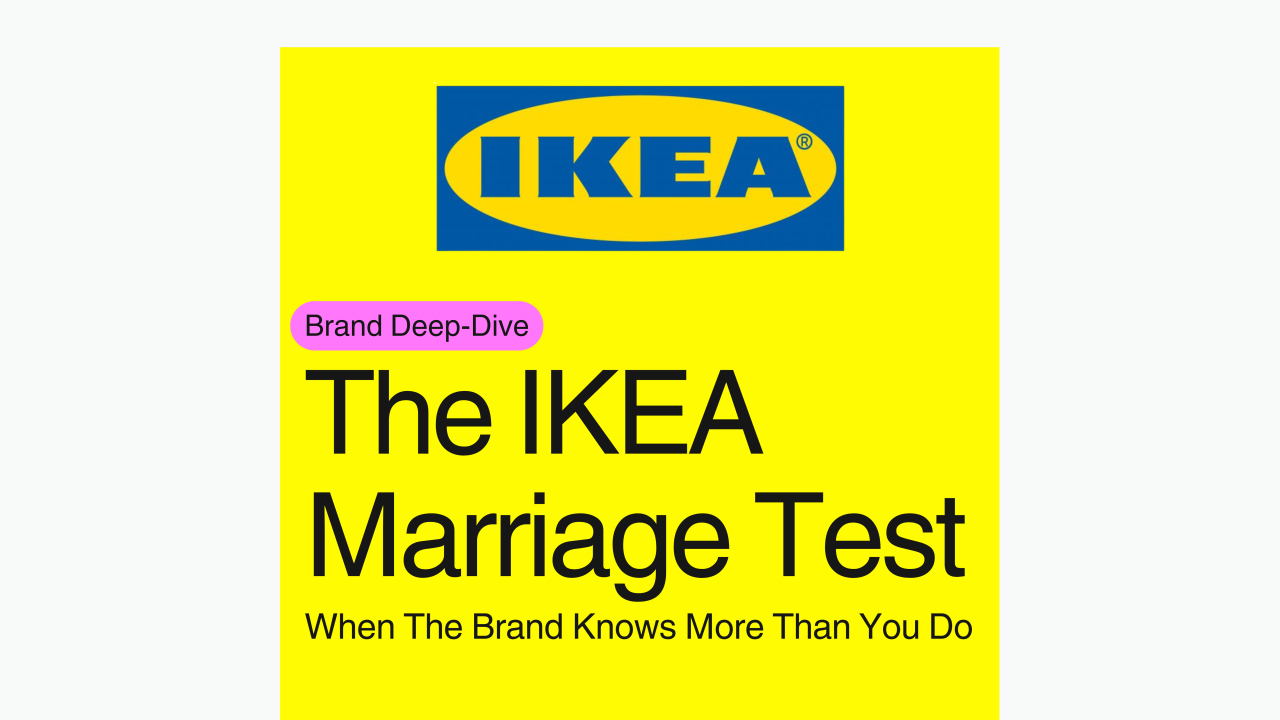What begins as a cheerful Saturday outing to furnish a first home often ends in tense discussions, passive-aggressive glances, and complete silence during the ride back.
Welcome to what many now refer to as the IKEA Marriage Test — an unspoken rite of passage for modern couples.
What’s fascinating is that IKEA never intentionally marketed it this way. Yet, it became a universally understood experience. Why?
Because IKEA isn’t just selling furniture. It has, perhaps unintentionally, become a brand that evokes emotion, memory, and meaning — the very elements that define real relationships.
The Psychology Behind the Pain: The IKEA Effect
Coined by researchers at Harvard Business School, the IKEA Effect describes a simple psychological phenomenon: “People place significantly higher value on things they help build.”
Even if the final product wobbles. Even if several screws are mysteriously left over.
In fact, especially then.
A few compelling statistics:
The IKEA Effect can increase the perceived value of a product by up to 63%
Emotionally invested customers are 52% more valuable than those who are merely satisfied
(Sources: HBR, Capgemini)
Add a partner to the equation, and it becomes even more meaningful: a co-created emotional attachment.
You didn’t just buy a table — you built it together. You didn’t just furnish a house — you tested the foundations of your relationship.
The Relationship Rollercoaster IKEA Never Planned (But Fully Owns)
The IKEA Marriage Test has become a global inside joke.
From social media memes and viral tweets to stand-up comedy routines, couples worldwide joke that surviving an IKEA trip is a milestone more memorable than anniversaries.
Here’s where IKEA demonstrated brilliant brand instinct: it didn’t resist the chaos. It embraced it.
They leaned into meme culture
They acknowledged the tension in campaigns
They positioned themselves as a brand that reflects real life, not just curated catalog moments
And that authenticity made them unforgettable.
Why Shared Struggle Creates Deeper Brand Loyalty
While most brands focus on reducing friction, IKEA designed an experience that includes it — and, in doing so, turned shopping into a bonding ritual.
You argue. You compromise. You laugh. You bond.
And that shared experience embeds the brand in your memory. It’s no longer just about furniture — it’s a chapter in your story.
Supporting data:
Shared emotional experiences increase brand recall by 22x
88% of consumers say that brand experiences requiring effort feel more rewarding
(Sources: Journal of Consumer Psychology, Edelman Trust Barometer)
Cultural Relevance IKEA Never Paid For
This isn't just a marketing success — it’s cultural capital.
Search “IKEA + couples” and you’ll find:
Instagram reels with millions of views
Reddit threads titled “We almost broke up over a nightstand”
Stand-up comedians using it as a punchline
Therapists referencing it as a metaphor for compatibility
And IKEA reaps the benefits — without lifting a finger.
What Every Brand Can Learn from IKEA
Here’s how any brand can build emotional stickiness — even if you’re not selling flat-pack furniture:
1. Create moments people remember
Don’t optimize everything for smoothness. Design moments people can feel — even if they involve a little chaos.
Think: onboarding flows, trial journeys, group participation.
2. Let your customers help build
Customization leads to commitment. When people co-create, they become emotionally invested.
D2C Example: Traya’s approach in the men’s hair care space is noteworthy.
3. Listen to your customers’ language
IKEA didn’t invent the “marriage test” — the internet did. Smart brands amplify what the culture already believes about them.
Ask: What memes could your brand inspire?
4. Design for togetherness
IKEA is a shared experience — rarely done solo. Consider how your brand can spark collaborative moments.
Example: Spotify Blend, Lenskart’s virtual try-on with friends.
Other Brands That Pass the Emotional Assembly Test
LEGO – Bonding over building
Decathlon – Shared adventure planning
Airbnb – Trust and tension in travel
Amul – Cultural commentary & family nostalgia
Starbucks – Ritual, routine, and social signaling
The common thread? These brands are not just used — they are remembered.
IKEA teaches us that emotion beats ease. That building something — even imperfectly — is more powerful than any loyalty program.
Love may be made in heaven, but it’s stress-tested in a self-checkout line, flat-pack shelf in hand, with one tiny Allen key between you.
And when you survive it, you don’t just grow closer to each other — you form a lasting connection with the brand that brought you there.


